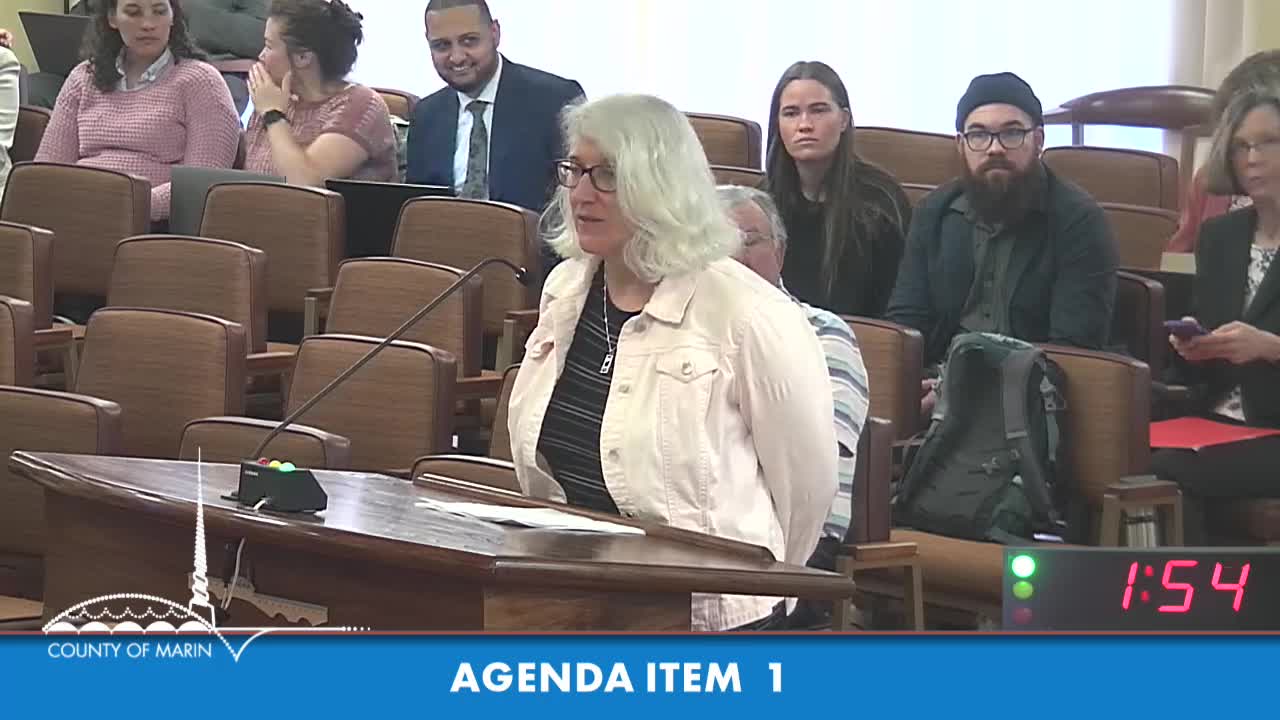County discusses homelessness prevention pilot as state 'HomeSafe' funding lapses
May 20, 2025 | Marin County, California
This article was created by AI summarizing key points discussed. AI makes mistakes, so for full details and context, please refer to the video of the full meeting. Please report any errors so we can fix them. Report an error »

Health and Human Services officials updated the Board of Supervisors May 19 on Marin’s homelessness response, reported recent housing gains and outlined a proposed homelessness prevention pilot to be developed with All Home and the Marin Community Foundation.
HHS Director Dr. Lisa Varhoos said the county has housed hundreds of residents under the Housing First approach since 2017, citing 887 chronically homeless people placed into housing with a 94% retention rate. The county also described several Homekey projects (Casa Canal, 1251 South Alicia, Pewett Place) and other successes for veterans and families.
Staff warned of new challenges. HHS said the governor’s May revise omitted funding for the HomeSafe program — a state program HHS said played a key role in short‑term motel placements and care for older adults and others with severe medical needs — and that the county is assessing the local impact. HHS also flagged uncertainty in federal voucher programs and a national appropriations environment that could reduce funding, creating a potential “voucher shortfall” for people the county is trying to house.
As a new approach, HHS and partners proposed a homelessness prevention pilot intended to help households at high risk of homelessness. All Home told staff it would invest about $1.0 million toward a regional pilot and the Marin Community Foundation offered a proposed $500,000 contribution; county staff indicated they would seek a $1.0 million county match as a one‑time allocation in the FY25‑26 budget. The proposed pilot would combine short‑term flexible financial assistance with case management and use a screening tool All Home has employed in other Bay Area jurisdictions; HHS said it would bring a full proposal and RFP back to the board for approval.
Board members asked staff to return with an operational design, metrics and details of coordination with cities, local nonprofits and the Marin Housing Authority. Public commenters — including frontline providers and community groups — supported prevention and urged attention to older adults and residents with long‑term housing needs.
HHS Director Dr. Lisa Varhoos said the county has housed hundreds of residents under the Housing First approach since 2017, citing 887 chronically homeless people placed into housing with a 94% retention rate. The county also described several Homekey projects (Casa Canal, 1251 South Alicia, Pewett Place) and other successes for veterans and families.
Staff warned of new challenges. HHS said the governor’s May revise omitted funding for the HomeSafe program — a state program HHS said played a key role in short‑term motel placements and care for older adults and others with severe medical needs — and that the county is assessing the local impact. HHS also flagged uncertainty in federal voucher programs and a national appropriations environment that could reduce funding, creating a potential “voucher shortfall” for people the county is trying to house.
As a new approach, HHS and partners proposed a homelessness prevention pilot intended to help households at high risk of homelessness. All Home told staff it would invest about $1.0 million toward a regional pilot and the Marin Community Foundation offered a proposed $500,000 contribution; county staff indicated they would seek a $1.0 million county match as a one‑time allocation in the FY25‑26 budget. The proposed pilot would combine short‑term flexible financial assistance with case management and use a screening tool All Home has employed in other Bay Area jurisdictions; HHS said it would bring a full proposal and RFP back to the board for approval.
Board members asked staff to return with an operational design, metrics and details of coordination with cities, local nonprofits and the Marin Housing Authority. Public commenters — including frontline providers and community groups — supported prevention and urged attention to older adults and residents with long‑term housing needs.
View full meeting
This article is based on a recent meeting—watch the full video and explore the complete transcript for deeper insights into the discussion.
View full meeting
